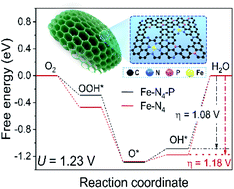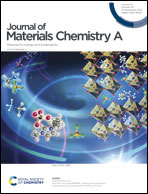Boosting the oxygen reduction reaction behaviour of atomic Fe–N4 active sites in porous honeycomb-like carbon via P heteroatom doping†
Abstract
Fe–N–C single atom electrocatalysts (SAECs) with porphyrin-like Fe–N4 species are one of the most promising alternatives to the platinum-group-metal-based electrocatalysts used for oxygen reduction reaction (ORR). However, limited attention is paid on delicately optimizing the free energy barrier of Fe–N4 active sites through heteroatom doping in the carbon skeleton. Herein, Fe single atoms (SAs) on heteroatoms N- and P-codoped porous honeycomb-like carbon (Fe–N4/NP-PHC) have been rationally designed. The as-developed Fe–N4/NP-PHC catalyst with abundant accessible active sites showed an impressive onset potential (Eonset = 1.0 V) and half-wave potential (E1/2 = 0.89 V) under low electrocatalyst loading capacity, which is more positive than those of Pt/C and most SAECs. Encouragingly, the experimental results and DFT calculations systematically demonstrated that the optimized adsorption energy of the Fe–N4 sites in the P-doped carbon matrix facilitated the release of OH* and thus boosted the ORR performance. The metal–air battery containing Fe–N4/NP-PHC exhibited high peak power density and long-term working feasibility with a low voltage gap at large current densities. This study demonstrates that P doping in carbon matrix is an effective strategy to promote catalytic properties and presents a novel avenue for developing high-performance electrocatalysts for various electrochemical reactions.



 Please wait while we load your content...
Please wait while we load your content...